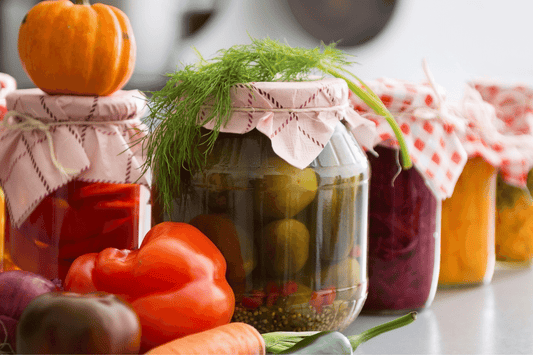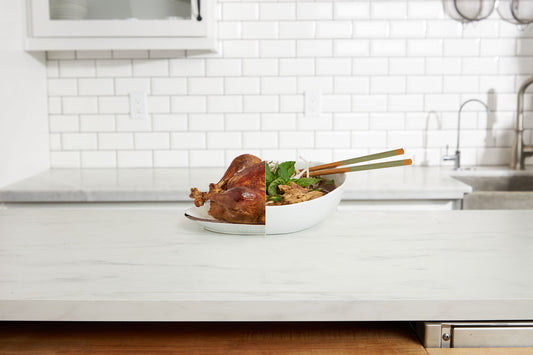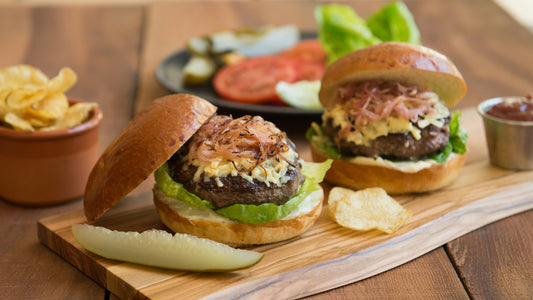By Julian Weisner, Culinary Scientist
Temperature Control is the Key to Culinary Consistency
Every time you read a recipe you are met with a range of vague instructions on what you should be hearing, smelling, or seeing, to ensure that you are cooking correctly. For example, here's step one for a tomato soup recipe from a well-known and popular food column for tomato soup:
“In a large pot, melt the butter over medium-low heat. Add onions and cook gently, stirring occasionally, until soft and translucent, about 20 minutes.”
Nothing vague about that, right? If you weren't able to decipher these instructions, you're not alone. First, you'll need to decipher“medium-low heat” and then determine what exactly “soft and translucent” means.
On top of that, you need to hope that you have combined all of these things correctly so that you reach “soft and translucent” in 20 minutes. If you have been cooking for years, you have surely built your own personal index for what each of these common words and phrases means. But as everyone learns when they first start, there is a steep learning curve to deciphering the cooking codex.
Step-by-Step Cooking Directions to Success
One of the few places where we do see consistently good results is through step-by-step, boxed recipes like brownies or cake mixes that are cooked in the oven. One-step or stir-n-bake cake and brownie mixes have been a jumping-off point for many early cooks not just because they are relatively easy to produce, but because they guarantee consistent results.
The reason that these baking mixes work so well, is that they work within a system that controls a few key factors; ingredient(s), technique, temperature, and time.
Ingredients
Let’s look at the first factor: the ingredients. The box mix does the heavy lifting by including all of the most error inducing ingredients perfectly measuring and mixed. The home cook is responsible for only adding the liquid and occasionally a few eggs. Both of these additions are pretty innocuous for the home cook. The manufactures of the box mix know exactly how much batter there will be, and what will be in it.
Technique
The second factor a box mix ensures is the technique. Luckily in an oven, we are almost always baking but think of this as the different recommendations for cake pans, and cupcake tins, glass brownie pans, or sheet trays; each of these items receive a different set of temperatures and times. This is because knowing how you are applying heat to your food can greatly change the way it cooks.
Temperature & Timing
This leads directly into factors three and four: temperature and time, the two greatest assets to the home cook. Not only do you know what temperature to set your oven at, but you have a relatively tight reference frame for how long your recipe will take to bake.
With the success of these four key factors, the baking aisle of the grocery store has boomed. And in reality, the only tool the home cook is employing from their side is temperature. Now you may have heard that everyone’s oven is different, this is true. There is a wide variety of differences between the way ovens control their temperature, and how accurately they do so, but after a couple of uses each person rapidly adjusts their home oven up and down a few degrees to compensate. A relatively easy solution.
Why Cook with Precise Temperature?
Precise temperature control bridges the gap between home cooking and professional skills. And with your Cue, you can set it to the precise temperature and let the pan do the work.
Our goal at Hestan Smart Cooking is to lower these and the many other barriers to entry. We want to make cooking easier in every direction. Compared to a restaurant, home cooks and recipes do a poor job of ensuring each person gets the appropriate outcome for every recipe. Unless there is a picture or video to follow along, there is no guarantee that what you have created even fulfills the author’s intent. You are left to question- does it taste good? Or does it taste right?
Writing Recipes with Temperature
Now let’s jump back to cooking, baking’s wild unkempt cousin. Every recipe informs you of the ingredients right in the beginning, so you have that. [check] Every recipe will inform you of a technique too, but this is usually inside of a step. Let’s return to our Tomato Soup recipe from before.
“In a large pot, melt the butter over medium-low heat. Add onions and cook gently, stirring occasionally, until soft and translucent, about 20 minutes.”
“...medium-low heat...stirring occasionally, until soft and translucent...”, this implies that the goal here is to cook down the vegetables without producing color. In a professional kitchen, this technique is specifically called sweating.
At Hestan Smart Cooking our answer to help home cooks produce food with the confidence and consistency of a professional chef is to add temperature control to the stovetop. Now instead of communicating with phrases like medium-high and hopeful time estimates, we can use defined values and concrete times. A step like this would instead read:
“Heat the Hestan Cue Chef’s Pot to 300° and melt the butter. Add onions and cook, stirring occasionally, for 20 minutes. The onions will be soft and translucent”
Notice the defined temperature, ingredients, time, and result. As a home cook, this can be an empowering tool.
Determining Temperatures for Culinary Techniques
In order to understand how to relate temperatures to technique, we needed to rely on the years of professional experience of our culinary team. Our team of professional chefs have over 50 years of combined work experience in Michelin Starred restaurants all across the world.

They built hundreds of recipes using temperature control, each chef cooked with their years of experience; watching, listening, and tasting along the way to make sure the food was cooking right. But instead of controlling a flame, they were directly controlling the temperature of the Hestan Cue pan.
Every one of our 500 recipes contains a multitude of cooking techniques, from sweating, sautéing, braising, searing, caramelizing- you name it. We were able to break each recipe apart into its component steps and categorize each cooking step based on its technique and temperature. We were then able to decipher how each technique relates to temperature. You may have seen our illustration of this in our Temperature Guide.
Temperatures Across Techniques
Precise Temperature Control for Sautéing
Let’s start by looking at our most common technique, sauté. Strictly speaking to sauté means to cook something quickly in a little bit of hot fat. The word literally means “jump” in French, which we know implies the rapid action in the pan while we are sautéing. Our chefs have produced over 1500 individual cooking steps across our recipes where they are using this technique. Each of these instances includes some amount of fat and vegetables. From onions to peppers, carrots, celery, mushrooms, and beyond. We compiled every single one of these steps and looked at their temperature, then grouped the steps into 25° intervals. This allowed us to clearly see the frequency of each temperature zone. Here are the results:
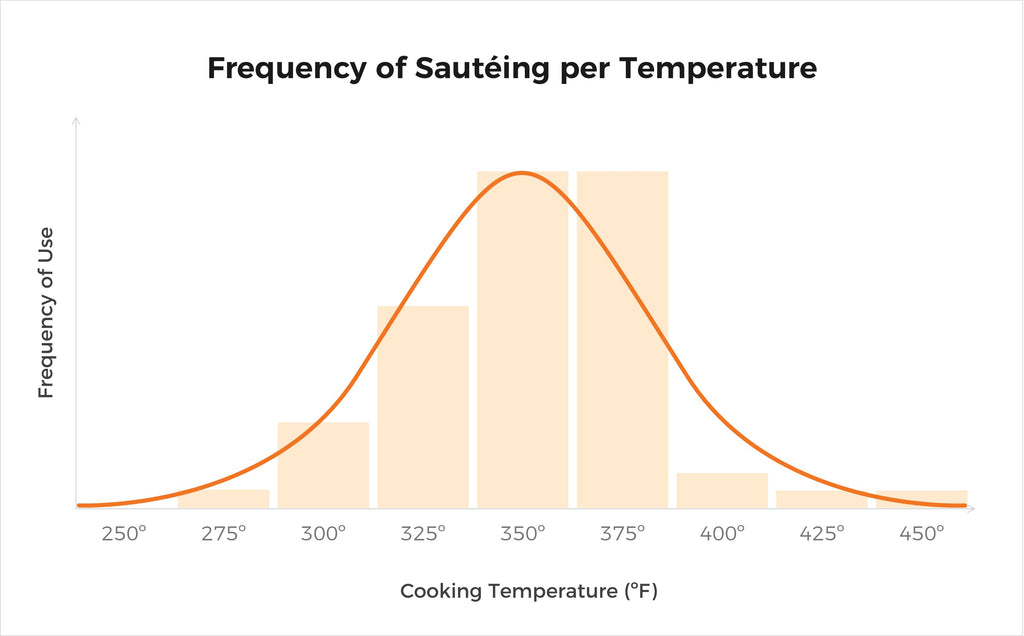
As you can see, they sauté at almost every temperature, this is because there is a wide variety of ingredients and preparations they are trying to produce with the same technique.
Think of sautéing finely diced ginger and garlic which both have a low moisture content, and a lot of surface area. Because these ingredients dehydrate and color quickly, we recommend lower temperatures for the prep.
Alternatively, ingredients bell peppers, which are much larger and richer in moisture content, are usually sautéed at higher temperatures. On average, it is clear that the chefs usually sauté somewhere near the middle of our spectrum, about 350°.
Suddenly every recipe that has recommended heating a pan on medium and cooking vegetables until they were lightly colored has even more clarity. We can say that 350° is the characteristic temperature for sautéing. In other words, if someone asks us, “what temperature do you sauté at” we would say 350° without dropping a beat.
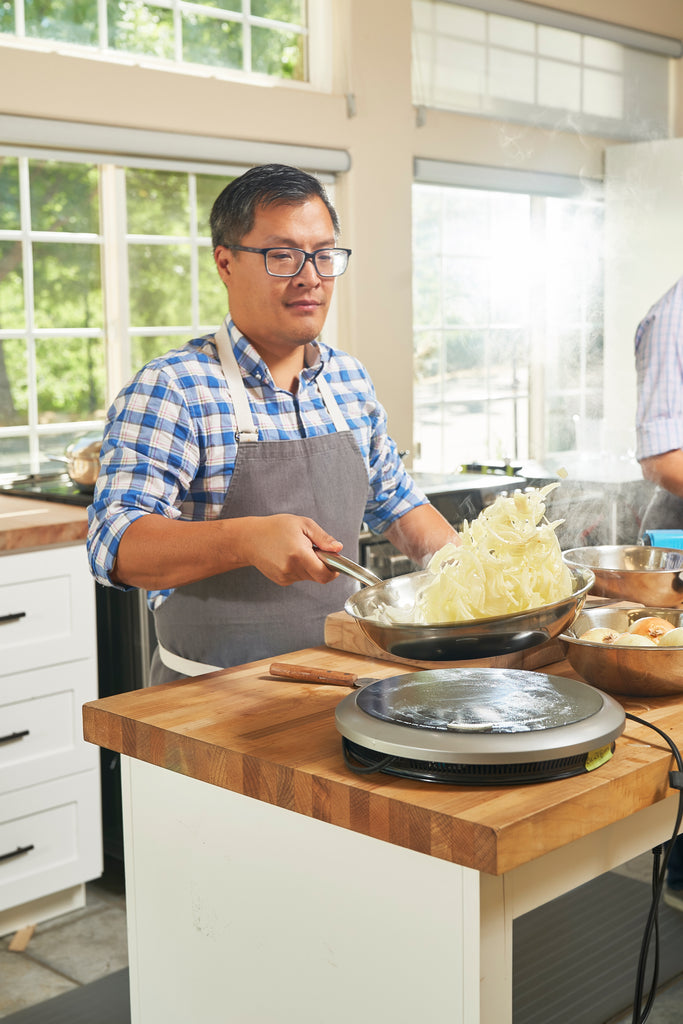
Precise Temperature Control for Searing
We can now do the same thing with a few other techniques to see how this plays out. Let’s look at sear. Searing is the technique we employ when we want to produce color and texture on a protein. Sometimes we want to produce a golden brown color on pork or chicken, and sometimes we want a rich dark crust on a steak, but all of these instances would be considered a sear. Let’s see how this plays out:
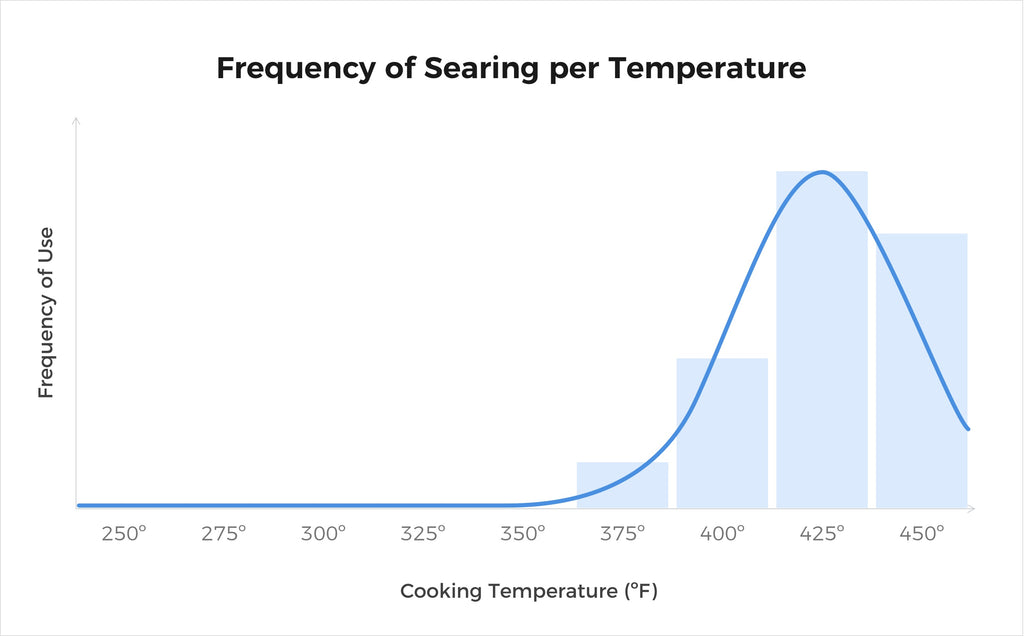
Interestingly enough we see that searing takes place only in the higher temperature range, this makes sense because we are just trying to impart color, and we do not care as much about cooking something all of the way through. It is clear that higher temperatures produce color faster.

Let’s look at one last technique- sweat.
Precise Temperature Control for "Sweating"
As mentioned above, sweating is when we are cooking vegetables without giving them color. Think of phrases like translucent, soft, and reduced. When we look at sweat against sauté and sear, we see some beautiful cooking magic illustrated:
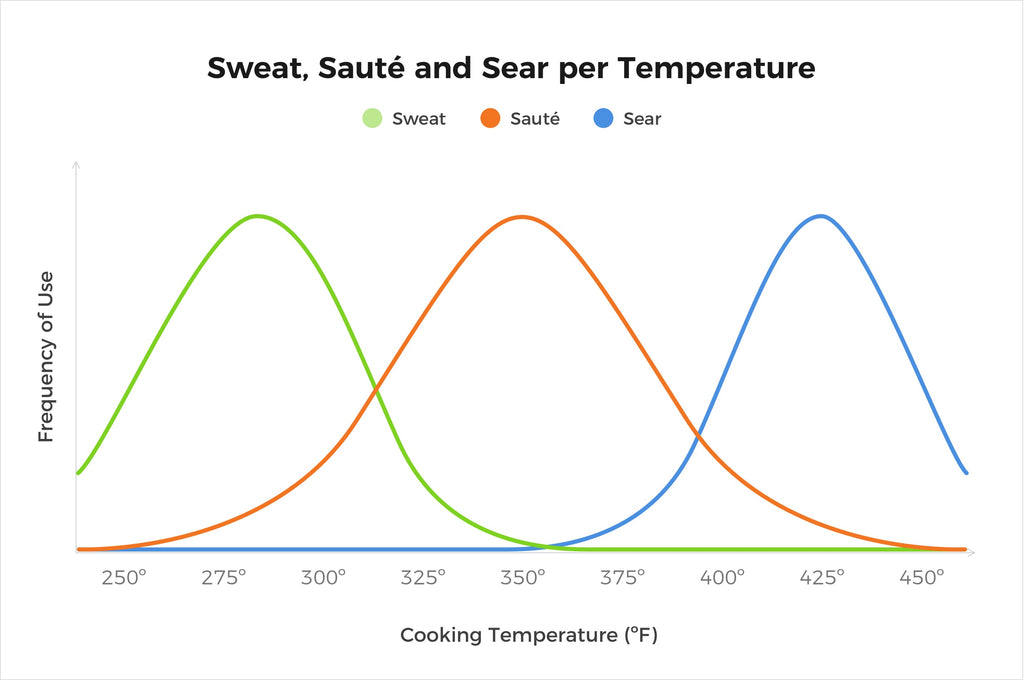
We can see the tighter curve of sear compared to sauté, and can understand how much the ingredients also affect the technique. Because sauté is a technique that spans so many ingredients and preparations, it has a much wider band of temperatures than sear, which is a bit more of a one-trick-pony.
We also see how sweat and sear are at the opposite ends of the spectrum. This makes so much sense since as a technique their goals are directly opposed. Sweating is cooking without producing color, while searing is building color and any cooking that happens is a happy accident. We see that sweat peaks at about 285°F, sauté at 355° and sear at 430°.
Now that you know what temperature relates to each technique, you can decode the recipe codex! Any recipe that is telling you to sweat- like the first step in your tomato soup- means you should heat your pan to around 285°.
For the complete list of techniques and temperatures that we have provided check out our Temperature Guide, and get cooking. If you have any comments, questions, or favorite temperatures that you have come across, post it on our FB page, those same Chefs are active in it every day and they would love to see how you are using temperature to revolutionize the kitchen.
By: Julian Weisner, Crazy Culinary Scientist


